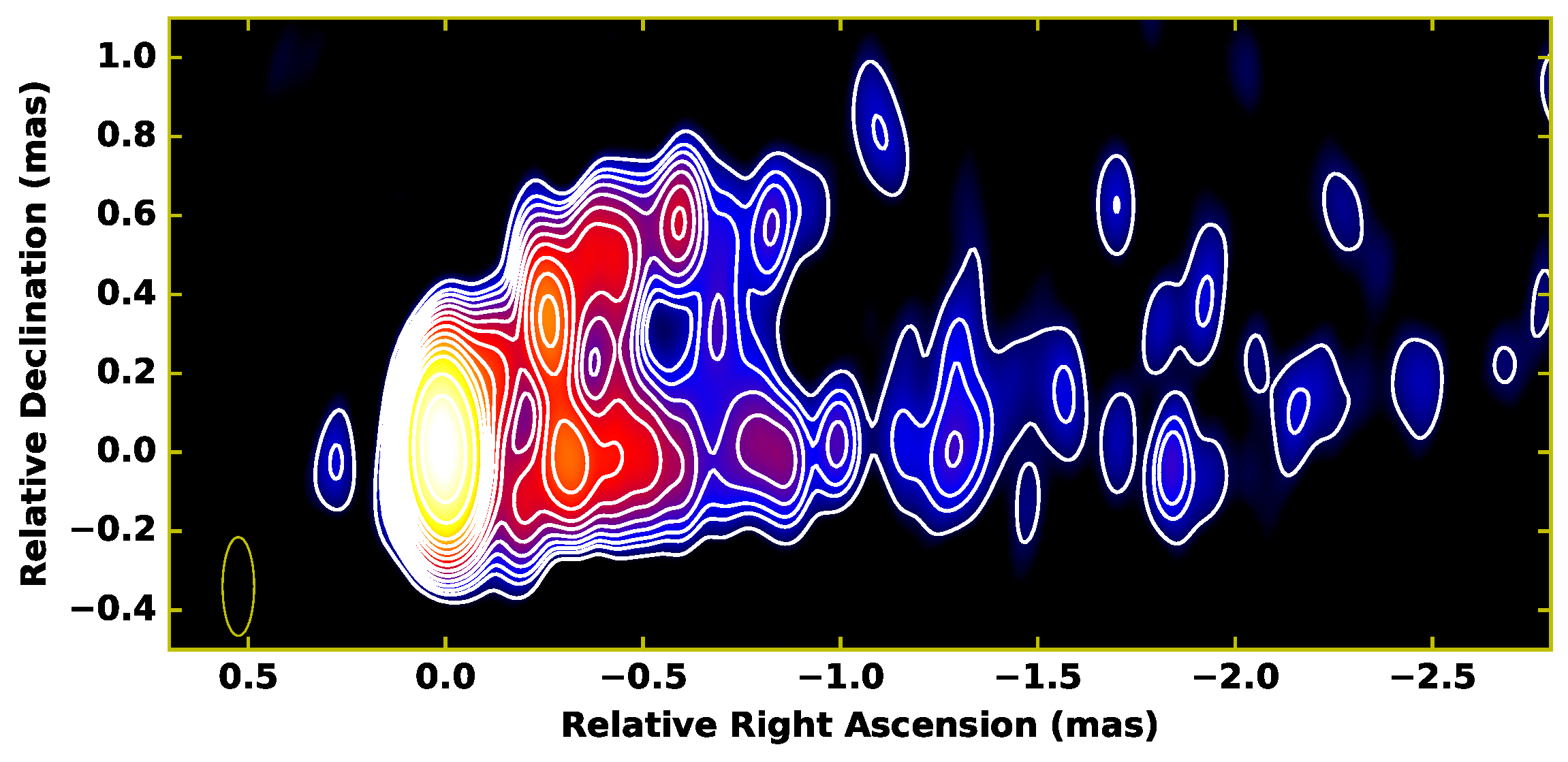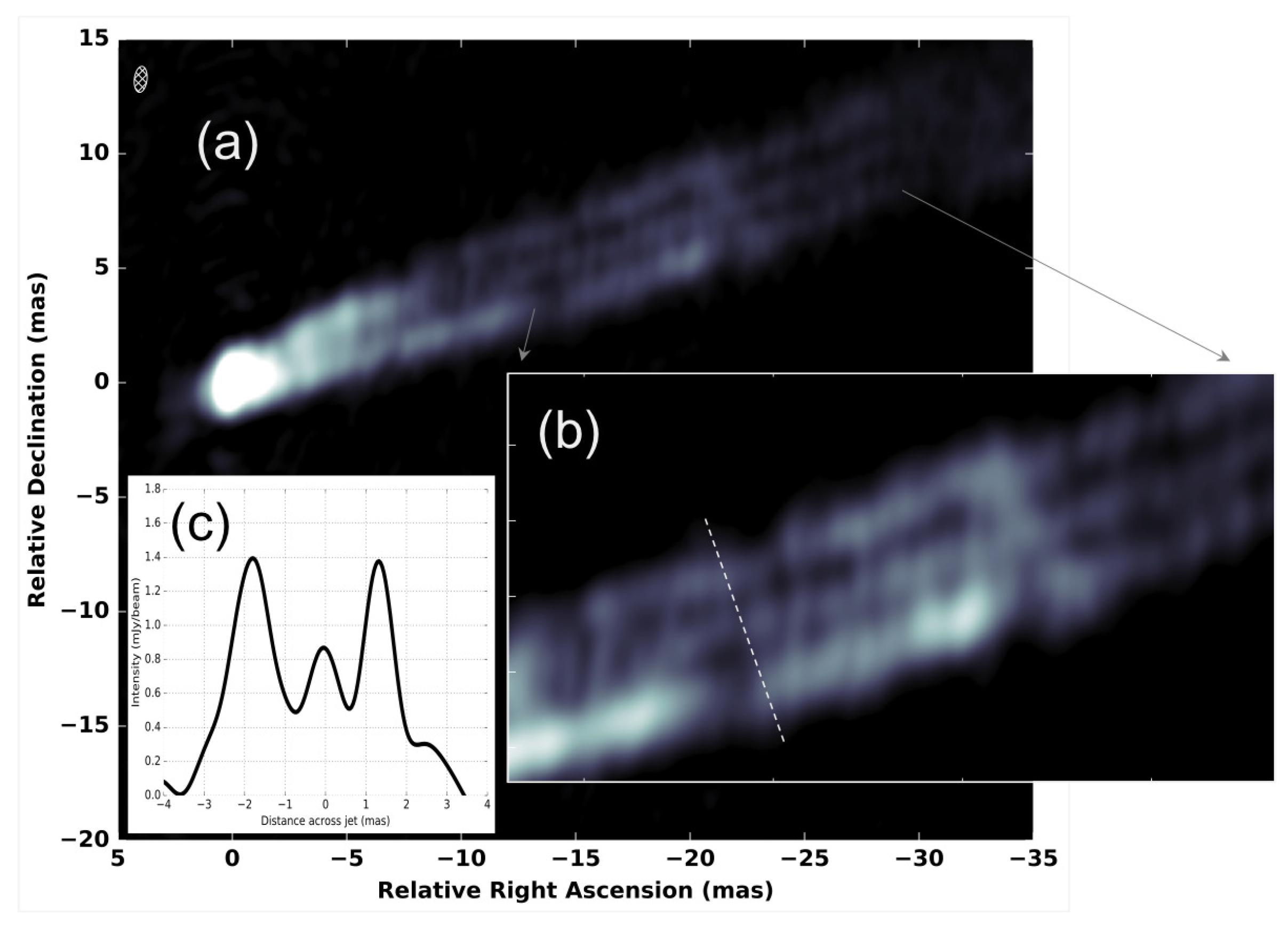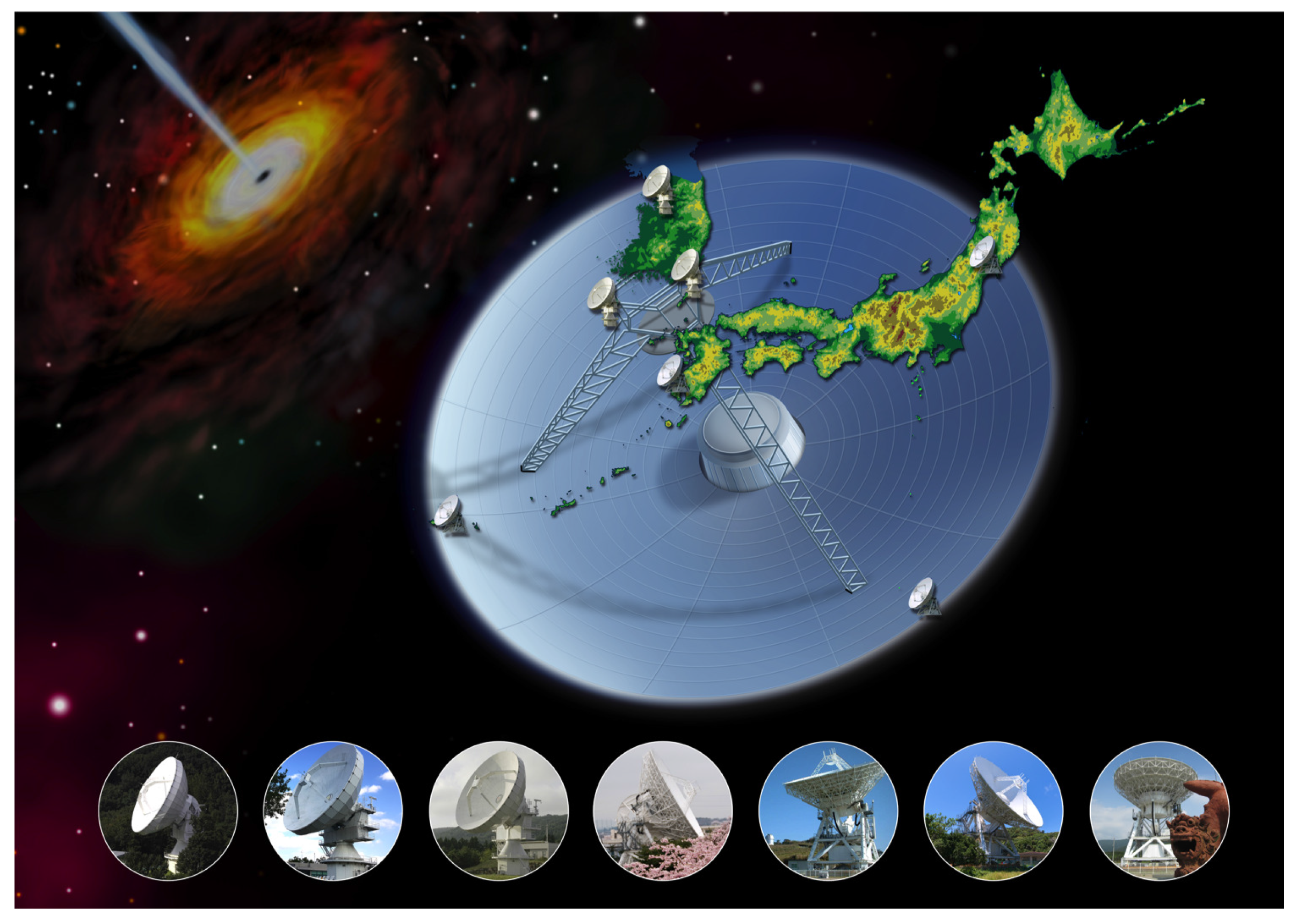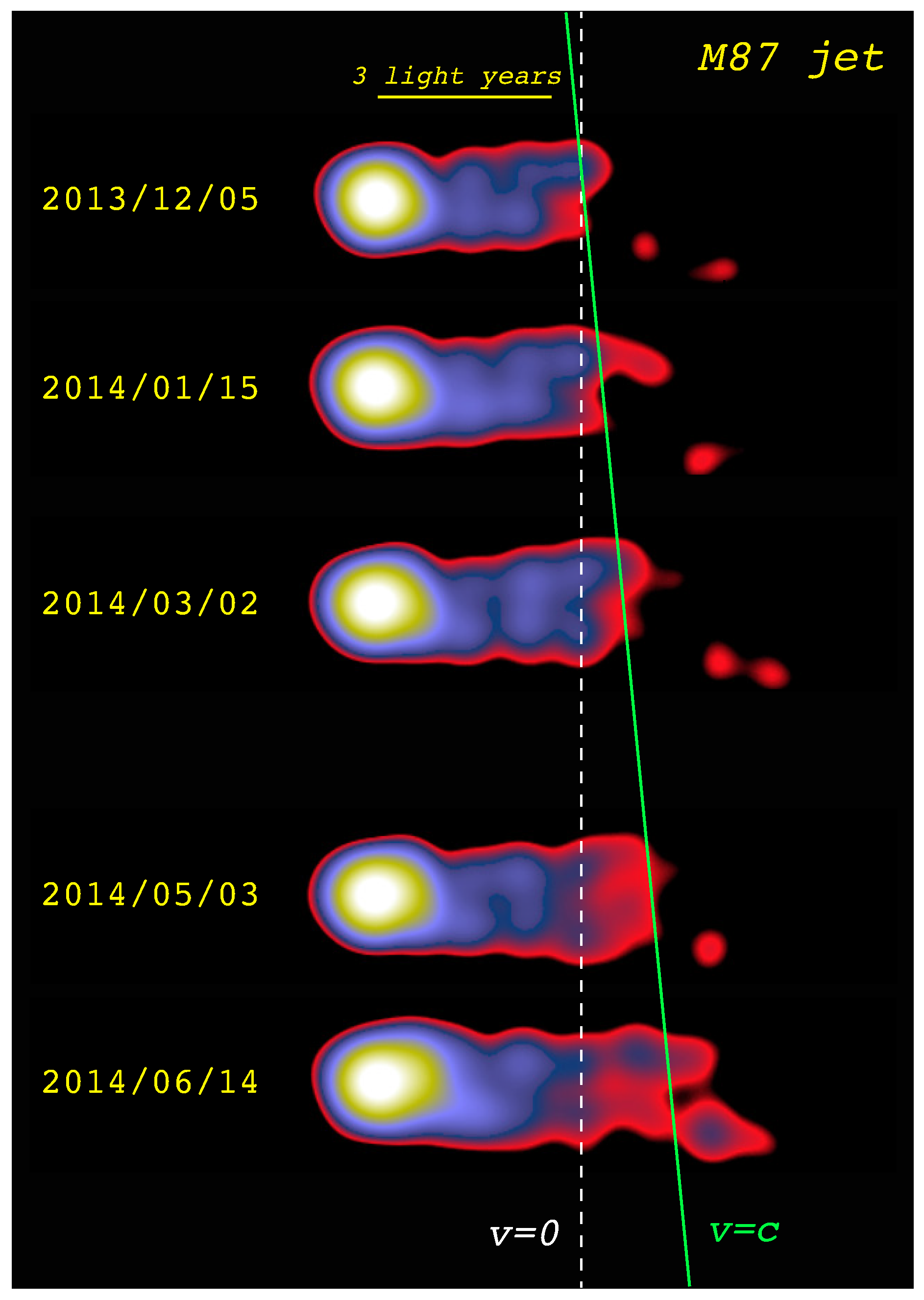The Structure and Propagation of the Misaligned Jet M87
Abstract
:1. Introduction
2. Jet Base Imaging at 86 GHz with HSA
3. Parsec-Scale Structure of the M87 Jet with the VLBA at 15 GHz
4. Sub-pc Jet Monitor of M87 with KaVA
4.1. Brief Summary of KaVA
4.2. Pilot Study of M87 Monitor with KaVA
5. Summary
Acknowledgments
Conflicts of Interest
References
- Lister, M.L.; Cohen, M.H.; Homan, D.C.; Kadler, M.; Kellermann, K.I.; Kovalev, Y.Y.; Ros, E.; Savolainen, T.; Zensus, J.A. Mojave: Monitoring of jets in active galactic nuclei with vlba experiments. VI. Kinematics analysis of a complete sample of blazar jets. Astrophys. J. 2009, 138, 1874–1892. [Google Scholar] [CrossRef]
- Walsh, J.L.; Barth, A.J.; Ho, L.C.; Sarzi, M. The M87 black hole mass from gas-dynamical models of space telescope imaging spectrograph observations. Astrophys. J. 2013, 770, 86–96. [Google Scholar] [CrossRef]
- Hada, K.; Doi, A.; Kino, M.; Nagai, H.; Hagiwara, Y.; Kawaguchi, N. An origin of the radio jet in M87 at the location of the central black hole. Nature 2011, 477, 185–187. [Google Scholar] [CrossRef] [PubMed]
- Doeleman, S.S.; Fish, V.L.; Schenck, D.E.; Beaudoin, C.; Blundell, R.; Bower, G.C.; Broderick, A.E.; Chamberlin, R.; Freund, R.; Friberg, P.; et al. Jet-Launching structure resolved near the supermassive black hole in M87. Science 2012, 338, 355–358. [Google Scholar] [CrossRef] [PubMed]
- Akiyama, K.; Lu, R.-S.; Fish, V.L.; Doeleman, S.S.; Broderick, A.E.; Dexter, J.; Hada, K.; Kino, M.; Nagai, H.; Honma, M.; et al. 230 GHz VLBI observations of M87: Event-horizon-scale structure during an enhanced very-high-energy γ-ray state in 2012. Astrophys. J. 2015, 807, 150–160. [Google Scholar] [CrossRef]
- Blandford, R.D.; Znajek, R.L. Electromagnetic extraction of energy from Kerr black holes. Mon. Not. R. Astron. Soc. 1977, 179, 433–456. [Google Scholar] [CrossRef]
- Blandford, R.D.; Payne, D.G. Hydromagnetic flows from accretion discs and the production of radio jets. Mon. Not. R. Astron. Soc. 1982, 199, 883–903. [Google Scholar] [CrossRef]
- Dexter, J.; McKinney, J.C.; Agol, E. The size of the jet launching region in M87. Mon. Not. R. Astron. Soc. 2012, 421, 1517–1528. [Google Scholar] [CrossRef]
- Mościbrodzka, M.; Falcke, H.; Shiokawa, H. General relativistic magnetohydrodynamical simulations of the jet in M87. Astron. Astrophys. 2016, 586, A38. [Google Scholar] [CrossRef]
- Asada, K.; Nakamura, M. The structure of the M87 jet: A transition from parabolic to conical streamlines. Astrophys. J. 2012, 745, L28–L32. [Google Scholar] [CrossRef]
- Hada, K.; Kino, M.; Doi, A.; Nagai, H.; Honma, M.; Hagiwara, Y.; Giroletti, M.; Giovannini, G.; Kawaguchi, N. The innermost collimation structure of the M87 jet down to ∼10 Schwarzschild radii. Astrophys. J. 2013, 775, 70–76. [Google Scholar] [CrossRef]
- Nakamura, M.; Asada, K. The Parabolic Jet Structure in M87 as a Magnetohydrodynamic Nozzle. Astrophys. J. 2013, 775, 118–128. [Google Scholar] [CrossRef]
- Cheung, C.C.; Harris, D.E.; Stawarz, Ł. Superluminal radio features in the M87 jet and the site of flaring TeV γ-ray emission. Astrophys. J. 2007, 663, L65–L68. [Google Scholar] [CrossRef]
- Acciari, V.A.; Aliu, E.; Arlen, T.; Bautista, M.; Beilicke, M.; Benbow, W.; Bradbury, S.M.; Buckley, J.H.; Bugaev, V.; Butt, Y.; et al. Radio imaging of the very-high-energy γ-ray emission region in the central engine of a radio galaxy. Science 2009, 325, 444–448. [Google Scholar] [PubMed]
- Abramowski, A.; Acero, F.; Aharonian, F.; Akhperjanian, A.G.; Anton, G.; Balzer, A.; Barnacka, A.; Barres de Almeida, U.; Becherini, Y.; Becker, J.; et al. The 2010 very high energy γ-ray flare and 10 years of multi-wavelength observations of M87. Astrophys. J. 2012, 746, 151–168. [Google Scholar] [CrossRef]
- Hada, K.; Kino, M.; Nagai, H.; Doi, A.; Hagiwara, Y.; Honma, M.; Giroletti, M.; Giovannini, G.; Kawaguchi, N. VLBI observations of the jet in M87 during the very high energy γ-ray flare in 2010 April. Astrophys. J. 2012, 760, 52–56. [Google Scholar] [CrossRef]
- Hada, K.; Giroletti, M.; Kino, M.; Giovannini, G.; D’Ammando, F.; Cheung, C.C.; Beilicke, M.; Nagai, H.; Doi, A.; Akiyama, K.; et al. A strong radio brightening at the jet base of M87 during the elevated very high energy gamma-ray state in 2012. Astrophys. J. 2014, 788, 165–177. [Google Scholar] [CrossRef]
- Kovalev, Y.Y.; Lister, M.L.; Homan, D.C.; Kellermann, K.I. The inner jet of the radio galaxy M87. Astrophys. J. 2007, 668, L27–L30. [Google Scholar] [CrossRef]
- Walker, R.C.; Ly, C.; Junor, W.; Hardee, P.J. A VLBA movie of the jet launch region in M87. J. Phys. Conf. Ser. 2008, 131, 012053. [Google Scholar] [CrossRef]
- Giroletti, M.; Hada, K.; Giovannini, G.; Casadio, C.; Beilicke, M.; Cesarini, A.; Cheung, C.C.; Doi, A.; Krawczynski, H.; Kino, M. The kinematic of HST-1 in the jet of M87. Astron. Astrophys. 2012, 538, L10–L13. [Google Scholar] [CrossRef]
- Asada, K.; Nakamura, M.; Doi, A.; Nagai, H.; Inoue, M. Discovery of sub- to superluminal motions in the M87 Jet: An implication of acceleration from sub-relativistic to relativistic speeds. Astrophys. J. 2014, 781, L2–L6. [Google Scholar] [CrossRef]
- Rioja, M.; Dodson, R. High-precision astrometric millimeter very long baseline interferometry using a new method for atmospheric calibration. Astron. J. 2011, 141, 114–128. [Google Scholar] [CrossRef]
- Krichbaum, T.P.; Graham, D.A.; Bremer, M.; Alef, W.; Witzel, A.; Zensus, J.A.; Eckart, A. Sub-Milliarcsecond Imaging of Sgr A* and M 87. J. Phys. Conf. Ser. 2006, 54, 328. [Google Scholar] [CrossRef]
- Hada, K.; Kino, M.; Doi, A.; Nagai, H.; Honma, M.; Akiyama, K.; Tazaki, F.; Lico, R.; Giroletti, M.; Giovannini, G.; et al. High-sensitivity 86 GHz (3.5 mm) VLBI observations of M87: Deep imaging of the jet base at a resolution of 10 schwarzschild radii. Astrophys. J. 2016, 817, 131–147. [Google Scholar] [CrossRef]
- Junor, W.; Biretta, J.A.; Livio, M. Formation of the radio jet in M87 at 100 Schwarzschild radii from the central black hole. Nature 1999, 401, 891–892. [Google Scholar]
- Ly, C.; Walker, R.C.; Junor, W. High-frequency VLBI imaging of the jet base of M87. Astrophys. J. 2007, 660, 200–205. [Google Scholar] [CrossRef]
- Kuo, C.Y.; Asada, K.; Rao, R.; Nakamura, M.; Algaba, J.C.; Liu, H.B.; Inoue, M.; Koch, P.M.; Ho, P.T.P.; Matsushita, S.; et al. Measuring mass accretion rate onto the supermassive black hole in M87 using faraday rotation measure with the submillimeter array. Astrophys. J. 2014, 783, L33–L37. [Google Scholar] [CrossRef]
- Ghisellini, G.; Tavecchio, F.; Chiaberge, M. Structured jets in TeV BL Lac objects and radiogalaxies. Implications for the observed properties. Astron. Astrophys. 2005, 432, 401–410. [Google Scholar] [CrossRef]
- Meyer, E.T.; Sparks, W.B.; Biretta, J.A.; Anderson, J.; Sohn, S.T.; van der Marel, R.P.; Norman, C.; Nakamura, M. Optical proper motion measurements of the M87 jet: New Results from the hubble space telescope. Astrophys. J. 2013, 774, L21–L26. [Google Scholar] [CrossRef]
- Biretta, J.A.; Sparks, W.B.; Macchetto, F. Hubble Space telescope observations of superluminal motion in the M87 jet. Astrophys. J. 1999, 520, 621–626. [Google Scholar] [CrossRef]
- Mertens, F.; Lobanov, A.P.; Walker, R.C.; Hardee, P.E. Kinematics of the jet in M 87 on scales of 100–1000 Schwarzschild radii. Astron. Astrophys. 2016, 595, 54–73. [Google Scholar] [CrossRef]
- Niinuma, K.; Lee, S.-S.; Kino, M.; Sohn, B.-W.; Akiyama, K.; Zhao, G.-Y.; Sawada-Satoh, S.; Trippe, S.; Hada, K.; Jung, T.; et al. VLBI observations of bright AGN jets with the KVN and VERA Array (KaVA): Evaluation of imaging capability. Publ. Astron. Soc. Jpn. 2014, 66, 103–118. [Google Scholar] [CrossRef]




© 2016 by the author. Licensee MDPI, Basel, Switzerland. This article is an open access article distributed under the terms and conditions of the Creative Commons Attribution (CC BY) license ( http://creativecommons.org/licenses/by/4.0/).
Share and Cite
Hada, K. The Structure and Propagation of the Misaligned Jet M87. Galaxies 2017, 5, 2. https://doi.org/10.3390/galaxies5010002
Hada K. The Structure and Propagation of the Misaligned Jet M87. Galaxies. 2017; 5(1):2. https://doi.org/10.3390/galaxies5010002
Chicago/Turabian StyleHada, Kazuhiro. 2017. "The Structure and Propagation of the Misaligned Jet M87" Galaxies 5, no. 1: 2. https://doi.org/10.3390/galaxies5010002
APA StyleHada, K. (2017). The Structure and Propagation of the Misaligned Jet M87. Galaxies, 5(1), 2. https://doi.org/10.3390/galaxies5010002





